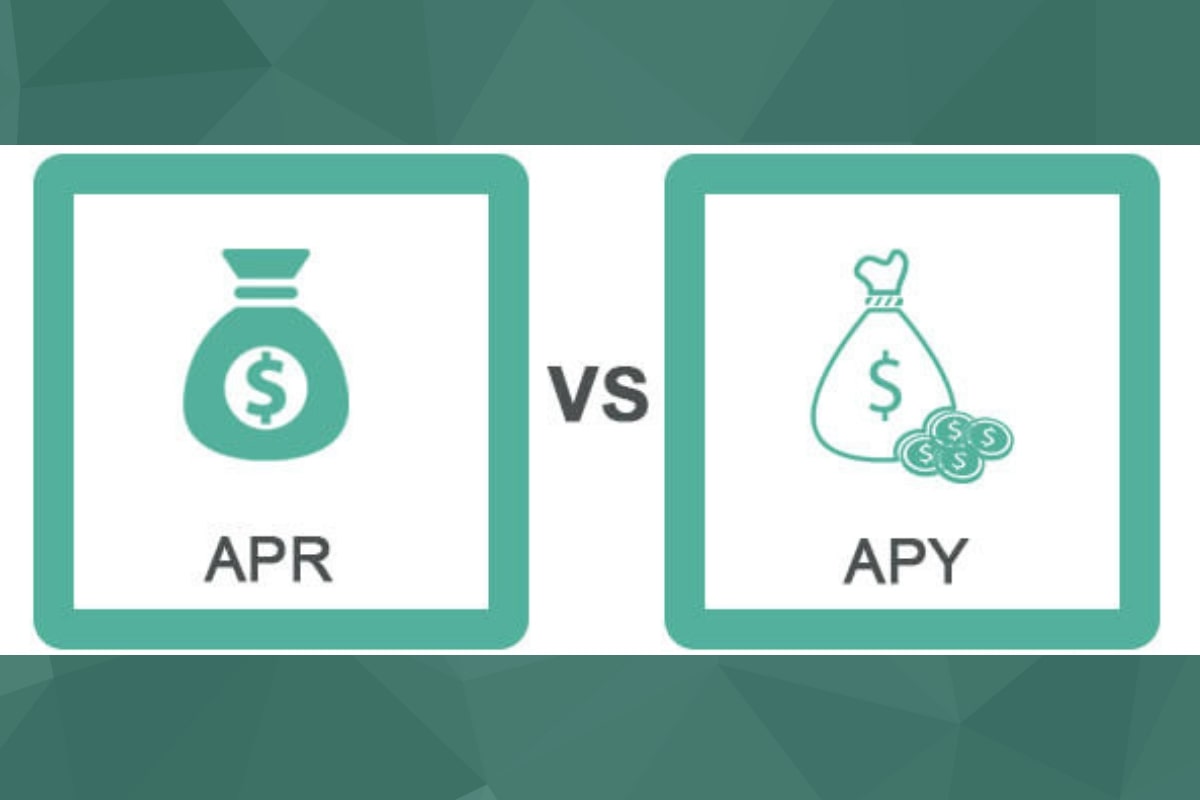

Finance
What Is APR In Crypto?
Published: March 3, 2024
Learn about the importance of APR in crypto finance and how it impacts your investments. Understand the significance of APR in the world of cryptocurrency.
(Many of the links in this article redirect to a specific reviewed product. Your purchase of these products through affiliate links helps to generate commission for LiveWell, at no extra cost. Learn more)
Table of Contents
Introduction
Understanding APR in Cryptocurrency
The world of cryptocurrency is dynamic and ever-evolving, offering a plethora of opportunities for investors and enthusiasts. As the market continues to expand, it introduces various financial concepts and terms that can be both intriguing and perplexing. One such term that holds significant importance in the realm of cryptocurrency is APR, which stands for Annual Percentage Rate.
Cryptocurrency platforms often entice users with the promise of attractive APR rates, aiming to attract liquidity and incentivize participation in various financial activities such as staking, lending, and yield farming. Understanding the concept of APR is crucial for anyone looking to engage with these platforms, as it directly impacts the potential returns and risks associated with different investment strategies.
In this article, we will delve into the intricacies of APR in cryptocurrency, exploring its significance, calculation methods, and the factors that influence its fluctuations. By gaining a comprehensive understanding of APR, readers will be better equipped to make informed decisions and navigate the dynamic landscape of crypto finance.
Stay tuned as we unravel the nuances of APR, shedding light on its role in the crypto ecosystem and providing valuable insights for both seasoned investors and newcomers alike.
Understanding APR in Cryptocurrency
Annual Percentage Rate (APR) in the context of cryptocurrency serves as a pivotal metric for evaluating the potential returns and costs associated with various financial activities within the crypto space. It represents the annualized interest rate or yield that an investor can earn or pay on their crypto assets through platforms offering staking, lending, or other forms of participation.
When a crypto platform promotes a specific APR, it signifies the projected annual percentage of return that participants can expect to receive based on their investment or contribution. For instance, in the case of staking, users lock up a certain amount of their cryptocurrency to support the network’s operations and, in return, receive rewards in the form of additional tokens or a percentage-based yield, typically expressed as an APR.
It’s important to note that APR can vary significantly across different crypto platforms and investment opportunities. While some platforms may offer enticing APR rates to attract liquidity and incentivize participation, it’s essential for investors to conduct thorough research and due diligence to assess the credibility and long-term sustainability of these offerings.
Furthermore, understanding the compounding effects of APR is crucial for investors, as it directly influences the overall growth of their crypto holdings. By comprehending how frequently the APR is compounded and the impact of compounding on the potential returns, investors can make informed decisions regarding the most suitable investment avenues within the crypto landscape.
As the crypto industry continues to innovate and introduce novel financial products and services, the concept of APR extends beyond traditional lending and borrowing, encompassing a wide array of decentralized finance (DeFi) protocols and yield-generating opportunities. Whether it’s providing liquidity in automated market maker (AMM) pools or participating in yield farming strategies, APR serves as a fundamental metric for evaluating the potential returns and risks associated with these activities.
By grasping the essence of APR in cryptocurrency, investors can navigate the diverse spectrum of financial opportunities with enhanced clarity and confidence, empowering them to make strategic investment decisions aligned with their financial objectives and risk tolerance.
How APR Differs from APY in Crypto
While both Annual Percentage Rate (APR) and Annual Percentage Yield (APY) are crucial metrics for evaluating potential returns in the realm of cryptocurrency, it’s essential to understand the distinctions between these two concepts to make informed investment decisions.
APR represents the annualized interest rate or yield without accounting for the effects of compounding. It provides a straightforward percentage that indicates the potential returns or costs associated with staking, lending, or other financial activities within the crypto space. However, APR does not consider the frequency of compounding, which can significantly impact the actual growth of an investment over time.
On the other hand, APY takes into account the effects of compounding, providing a more comprehensive reflection of the potential growth of an investment over a year. By factoring in the compounding frequency, APY offers a more accurate representation of the effective annual yield that an investor can expect to receive.
When evaluating investment opportunities in cryptocurrency, understanding the difference between APR and APY is paramount. While a platform may advertise an attractive APR, it’s crucial for investors to inquire about the compounding frequency and consider the corresponding APY to gauge the actual growth potential of their investments.
Furthermore, in the dynamic and rapidly evolving landscape of decentralized finance (DeFi), where yield-generating opportunities abound, the distinction between APR and APY becomes even more critical. Investors engaging in liquidity provision, yield farming, or other DeFi strategies must carefully assess the APY of their chosen platforms to make well-informed decisions aligned with their financial goals and risk tolerance.
By recognizing the nuances between APR and APY in the context of cryptocurrency, investors can navigate the diverse array of investment opportunities with enhanced clarity, ensuring that they accurately evaluate the potential returns and risks associated with their participation in various crypto financial activities.
Factors Affecting APR in Crypto
Several key factors influence the Annual Percentage Rate (APR) offered by cryptocurrency platforms, shaping the potential returns and risks associated with various financial activities within the crypto space. Understanding these factors is essential for investors looking to assess the credibility and sustainability of APR offerings and make informed decisions regarding their participation in crypto-based investment opportunities.
Market Volatility: The inherent volatility of cryptocurrency markets plays a significant role in determining APR. Platforms offering staking, lending, or yield-generating opportunities often adjust their APR rates in response to market conditions. During periods of heightened volatility, APR rates may fluctuate to reflect the changing dynamics of the crypto market, impacting the potential returns for investors.
Network Participation: The level of participation and engagement within a crypto network can influence the APR offered to participants. In Proof of Stake (PoS) networks, for example, the APR for staking activities may be influenced by the overall network participation and the amount of tokens being staked. Higher levels of network participation could lead to adjustments in APR rates to incentivize continued engagement and secure the network.
Platform Governance and Protocol Changes: Decentralized finance (DeFi) platforms and protocols are governed by community-driven mechanisms that can lead to changes in APR. Governance proposals and protocol upgrades within DeFi ecosystems may impact the APR rates for liquidity provision, yield farming, and other activities, as the community collectively decides on adjustments to incentivize or balance participation.
Supply and Demand Dynamics: The supply and demand dynamics of specific cryptocurrencies and tokens can influence the APR offered by platforms. In lending and borrowing protocols, the availability of assets for lending and the demand for borrowing can impact the APR rates, reflecting the market conditions and the prevailing interest in utilizing these financial services within the crypto ecosystem.
Platform Risk and Security: The overall risk profile and security measures implemented by cryptocurrency platforms can impact the APR rates they offer. Platforms with robust security protocols and risk management frameworks may be able to offer competitive APR rates to users, reflecting the platform’s commitment to safeguarding users’ assets and fostering trust within the community.
By considering these factors, investors can gain valuable insights into the dynamics of APR in the crypto space, enabling them to make well-informed decisions regarding their participation in staking, lending, yield farming, and other financial activities within the cryptocurrency ecosystem.
Importance of APR in Crypto
The Annual Percentage Rate (APR) holds significant importance in the realm of cryptocurrency, playing a pivotal role in shaping investment decisions, incentivizing user participation, and fostering the growth of decentralized financial ecosystems. Understanding the importance of APR is essential for investors and participants engaging in various financial activities within the crypto space.
Transparent Yield Projections: APR provides investors with a transparent metric for evaluating the potential annualized returns on their crypto assets. By considering the APR offered by staking platforms, lending protocols, and yield-generating opportunities, investors can assess the projected yields and make informed decisions regarding the allocation of their assets, aligning with their financial objectives and risk tolerance.
Incentivizing Participation: Platforms offering competitive APR rates incentivize user participation in staking, liquidity provision, and other DeFi activities, contributing to the overall growth and security of crypto networks. Higher APR rates can attract liquidity, encourage long-term asset holding, and foster active engagement within decentralized ecosystems, bolstering the resilience and functionality of crypto protocols.
Diversification of Investment Strategies: APR empowers investors to diversify their crypto investment strategies by considering the potential returns from different financial activities. Whether it’s earning staking rewards, participating in liquidity pools, or utilizing lending protocols, APR serves as a fundamental metric for evaluating the yield-generating potential across diverse investment avenues, enabling investors to optimize their asset allocation strategies.
Evaluating Risk-Adjusted Returns: APR allows investors to evaluate the risk-adjusted returns associated with various crypto investment opportunities. By comparing the APR rates offered by different platforms and protocols, investors can assess the potential returns in relation to the associated risks, enabling them to make well-informed decisions aligned with their risk appetite and investment preferences.
Fostering Financial Inclusion: Accessible APR rates in DeFi platforms and crypto lending protocols contribute to financial inclusion by offering individuals the opportunity to earn yields on their digital assets. This inclusive framework enables users to actively participate in the crypto economy, potentially earning passive income and engaging with innovative financial services that transcend traditional barriers to entry.
By recognizing the importance of APR in cryptocurrency, investors and participants can navigate the dynamic landscape of decentralized finance with enhanced clarity, leveraging APR as a fundamental tool for evaluating potential returns, diversifying investment strategies, and contributing to the growth and resilience of the broader crypto ecosystem.
Conclusion
As the cryptocurrency ecosystem continues to evolve, the concept of Annual Percentage Rate (APR) emerges as a crucial metric that shapes investment strategies, incentivizes user participation, and fosters the growth of decentralized financial ecosystems. By gaining a comprehensive understanding of APR in the context of cryptocurrency, investors and enthusiasts can make informed decisions regarding staking, lending, yield farming, and other financial activities within the dynamic crypto landscape.
Understanding the nuances of APR empowers investors to evaluate potential yields, diversify investment strategies, and navigate the diverse array of yield-generating opportunities offered by decentralized finance (DeFi) platforms. By considering the factors influencing APR, such as market volatility, network participation, and platform governance, investors can gain valuable insights into the dynamics of APR rates and make well-informed decisions aligned with their financial objectives and risk tolerance.
Moreover, recognizing the distinction between APR and Annual Percentage Yield (APY) enables investors to accurately assess the compounding effects on their potential returns, ensuring a comprehensive evaluation of investment opportunities in the crypto space. The transparent yield projections provided by APR, coupled with the incentivization of user participation and the diversification of investment strategies, contribute to the resilience and inclusivity of the crypto economy.
Ultimately, APR serves as a fundamental tool for evaluating risk-adjusted returns, fostering financial inclusion, and empowering individuals to actively engage with innovative financial services within the crypto ecosystem. By leveraging the importance of APR, investors can contribute to the growth and sustainability of decentralized financial networks while optimizing their asset allocation strategies and potentially earning passive income on their digital assets.
In conclusion, a comprehensive understanding of APR in cryptocurrency equips investors with the knowledge and insights necessary to navigate the dynamic landscape of decentralized finance, make informed investment decisions, and actively participate in the transformative potential of the crypto economy.














